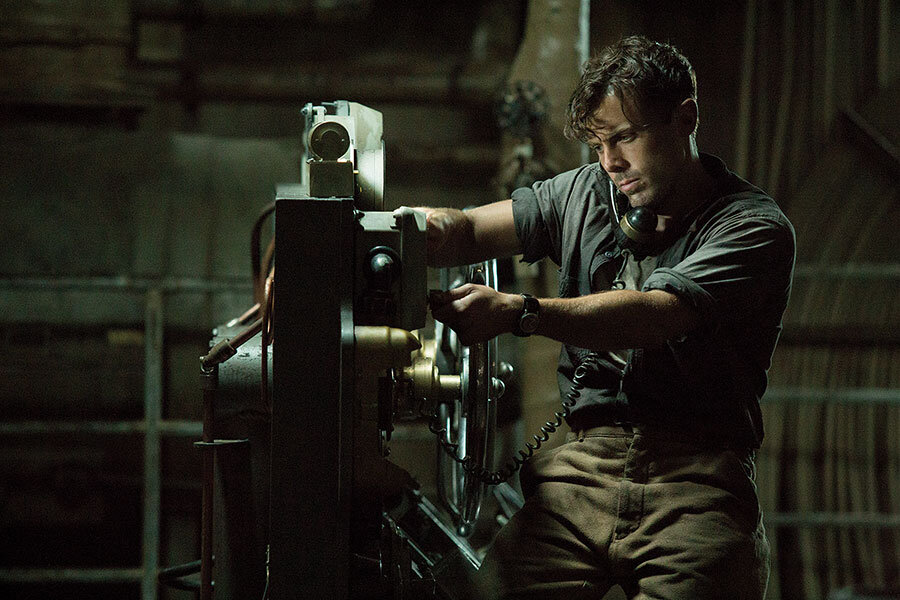'The Finest Hours' is a seafaring story that's resolutely old-fashioned
Loading...
Like “In the Heart of the Sea,” “The Finest Hours” is another storm-at-sea movie, only this one doesn’t costar a white whale. It’s about a true-life US Coast Guard rescue mission off Cape Cod in the winter of 1952, when an oil tanker sheared in two and a small crew from the Chatham station went searching for survivors in a tempest that came close to claiming their lives.
Since the facts of the story are in the public record, and the book it’s based on is subtitled “The True Story Behind the U.S. Coast Guard’s Most Daring Sea Rescue,” the outcome is never in any real doubt. Watching this movie is a bit like watching “The Longest Day.” You already know the ending, but you want to know what led up to it.
Actually, “The Longest Night” would be a better title for this movie than “The Finest Hours,” which summons up images of Winston Churchill and U-boats. Nothing so grand is on display here. Director Craig Gillespie and his screenwriters, Scott Silver, Paul Tamasy, and Eric Johnson, have crafted a movie that could have been made, except for the CGI effects, in 1952. The same retroness was rampant in “In the Heart of the Sea.” What is it about seafaring movies that compels their directors to go all stiff and stalwart on us?
It’s not just the technique of this movie that is resolutely old-fashioned. So are its attitudes. The film may feature practically wall-to-wall monster storms but undergirding it all is a cushion of straight-arrow sentimentalism. It harks back to a rosy neverland when men were men and women stood by them.
Chief hero is Bernie Webber (Chris Pine), who has always dreamed of being in the Coast Guard. He’s an aw-shucks, by-the-book kind of guy; he even feels the need to ask permission of his new boss, Daniel Cluff (Eric Bana), before he proposes to his peachy-keen fiancée, Miriam (Holliday Grainger, who, in a far nastier mode, played one of the stepsisters in “Cinderella”). Because he doesn’t want Miriam to continually fret about losing him at sea, he even holds out on a marriage proposal during their courtship until she ends up popping the question herself (an act that invites much ribbing, some not-so-good-natured, from his cohorts).
Sure enough, when the nor’easter hits, Webber and three hardy souls set out in a 36-foot boat to rescue the tanker, the Pendleton, not knowing if there are even any survivors aboard (or if they themselves will survive). Miriam, who looks like a Kewpie doll but has a will of iron, strides into the all-male domain of the Coast Guard station and demands Cluff bring the boys back, to no avail. Meanwhile, on the Pendleton, Gillespie plays out a parallel story to Webber’s. The equally stalwart and navigationally adept tanker engineer Raymond Sybert (Casey Affleck) is literally trying to hold things together. Many of his surly crewmates don’t much like Sybert, who is so soft-spoken he’s almost mute. Worse, he’s single. Several married crewmen suspect he couldn’t care less about their lives. In the film’s best exchange, and in one of Sybert’s most extended stretches of dialogue, he fires back: “I’ve got a life just the same as you.”
We learn very little about Sybert but, as Affleck plays him, he’s easily the most compelling figure in “The Finest Hours.” (It helps that Affleck, Cape Cod-born, has the film’s only authentic Massachusetts accent.) Webber’s stalwartness is admirable but also a little boring: In the midst of howling maelstroms that would give King Lear pause, Webber is ever the straight arrow. Sybert doesn’t lose control either, but we sense the banked fires beneath his resoluteness. When these two guys end up side by side in the rescue boat, their clenched jaws and manly half-smiles could probably be made out from the moon.
As usual with these kinds of films, the end credits offer up photos of the real-life participants, and, as usual, those photos have more emotional resonance than anything in the movie. Maybe it’s just the History channel junkie in me, but I would much rather be seeing a documentary about this mission than a trumped-up drama featuring brand-name actors and CGI squalls. Grade: C+ (Rated PG-13 for intense sequences of peril.)







